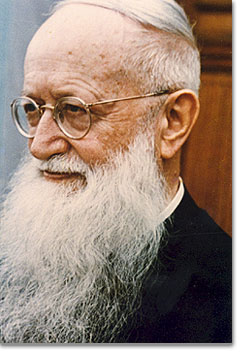 |
|
Padre José Kentenich, fundador de Schoenstatt. Su proceso de canonización comenzó en 1975 Father Joseph Kentenich, founder of Schoenstatt. His process of canonization began 1975 Pater Josef Kentenich, Gründer Schönstatts. Sein Heiligsprechungsprozess begann 1975 Foto: Sekretariat Pater Josef Kentenich © 2005 |
|
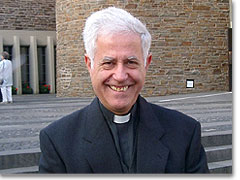 |
|
P. Angel Strada, postulador Fr. Angel Strada, postulator P. Angel Strada, Postulator Foto: POS Fischer © 2005 |
|
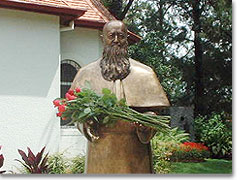 |
|
Testimonios de su presencia: Estatua de Padre José Kentenich (en Nuevo Schoenstatt, Argentina) Testimonies of his presence: Statue of Fr. Joseph
Kentenich (in Nuevo Schoenstatt, Zeugtnis seiner Gegenwart: Statue Pater Kentenichs (in Nuevo Schoenstatt, Argentinien) Foto: Crivelli © 2005 |
|
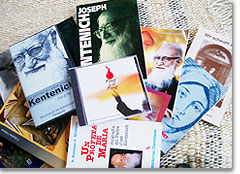 |
|
Presente en CDs, videos, biografias... Present in CDs, videos, biographies... Gegenwärtig in CDs, Videos, Biographien... Foto: POS Fischer © 2005 |
|
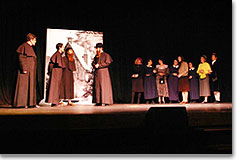 |
|
Teatro sobre su vida: Kentenich, un hombre, una misión Theater about his life: Kentenich, a man, a mission Theateraufführung über sein Leben: Kentenich, ein Mensch, eine Sendung Foto: Martín © 2005 |
|
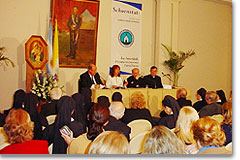 |
|
Simposio sobre su pedagogía Simposion on his pedagogy Symposium zu seiner Pädagogik Foto: Crivelli © 2005 |
|
PK. Reporter Patricia Navas interviewed Father Angel L. Strada for the Spanish news agency VERITAS. The postulator for the cause of canonization of Joseph Kentenich assures that Pope Benedict XVI values positively the founder of the apostolic movement of Schoenstatt even though he will not intervene in the processing of the process.
In this interview, Fr. Angel Strada speaks on the progress of the process and on what still needs to be done.
What is the actual state of the process of canonization of the founder of Schoenstatt?
The process was initiated in the diocese of Treveris on February 10, 1975, seven years after the death of Father Kentenich. Throughout these thirty years, a great number of signs regarding the reputation of sanctity have been gathered. Thousands of persons living in 87 countries and 5 continents have certified that they turn to his intercession or live their lives according to his example. The numerous published writings were examined by four specialists in theology who attest that they find nothing contrary to the dogma or the morality of the Church. More than one hundred witnesses have made their declarations before the ecclesiastical tribunal. This is of particular importance since the objective of the process is the verification of the heroic life and virtues of the servant of God. The witnesses are questioned on the memories and experiences they had in direct contact, and in many cases, for decades, with Father Kentenich. They may demonstrate in favor of or against, ask their questions, present documentation, etc.
In recent years, the work concentrated on collecting and evaluating the writings not published: letters written by him or addressed to him, personal documents, conferences and retreats not edited, etc. A commission of experts in church history and archives has been responsible in directing the task. The great quantity of these writings has required much time and energy. Documentation was required in more than 110 ecclesiastic and civil archives. For the archives and for the witnesses, where Father Kentenich lived and where he developed his pastoral activity was taken into consideration: Germany, Rome, Switzerland, USA, Brazil, Chile, Argentina, Uruguay, South Africa. Once the commission of historians has completed its task –this is forseen in the next few months—few procedures will be lacking to finalize the diocesan phase of the process. The meeting of definitors will then follow in Rome. It is impossible to predict when it will be completed. Among other reasons is that a miracle is required for beatification. No one can "organize" a miracle; it can only be prayed for.
What are the main obstacles lengthening the process?
Thirty years duration is not necessarily too long a time for the beatification process of a confessor. The causes of martyrs, in general, take less time and a miracle is not required. We must not use as a measure the causes like that of Mother Teresa of Calcutta or of Msgr. Escrivá de Balaguer which for different reasons took less time. In the case of Father Kentenich, his long life of 82 years has been an influencing factor…..the enormous amount of documentation…..his confrontation with national socialism and his almost four years of imprisonment in the Dachau Concentration Camp …..the difficulties he had with his own community of Pallottine Fathers…..the fourteen years of separation from his foundation mandated by the then called Holy Office…..the pastoral and theological propositions he made in anticipation of the Second Vatican Council, etc. Many of these themes have demanded a long and exhaustive investigation.
In addition, there were difficulties in the procedure of the said process. It began when the old legislation was still in force. This changed in 1983 and virtually a new beginning had to be initiated. The Treveris Diocese delayed several years in naming a successor to the first Episcopal delegate who died suddenly. The successor suffered various illnesses which impeded his full dedication to the cause. Also, until now, there has not been a miracle produced through the intercession of Father Kentenich. The opening of a process with a miracle normally influences the acceleration of the process of virtues.
Do you think that the German nationality of the Pope can help to facilitate the process?
Benedict XVI knows the personality and the Work of Father Kentenich. In fact, in the south of Germany where he lived as a youth and where a good part of his educational activity and of his Episcopal ministry took place, the Schoenstatt Movement has many followers among the clergy and the laity. A sign of his positive evaluation is what he wrote in October of 1989 promoting a novena dedicated to Father Kentenich: "Pope John Paul II, on his first visit to Germany, pointed to Father Kentenich as a ‘renowned priest’ in recent history.’ From his life, from his words and his life, a radiant light comes forth capable of guiding the way. On his tomb is inscribed the motto which guided him, formed him and with which he modeled many: ‘Dilexit Ecclesiam’ (‘He loved the Church’). May Mary, the Mother of the Church by whom he always allowed himself to be helped, protect us and watch over us. Through her faithful servant, Father Joseph Kentenich, may she open to many the way of love for the Church so that there may be a new vigor and a new joy of faith which will inundate our people and our land."
What would the benefit be for the Church?
"The saints, also the anonymous ones, are the greatest success of the Church," has recently been said by Cardinal Lustiger. In fact, they are the clear demonstration that the values of the Gospel are practicable and are not reduced to a mere declaration of good values or unobtainable ideals. Christ announced that his mission was to give us life, life in abundance. Can one believe in such a life if in no one and never has it been shown as powerful? In the lives of the saints, the transforming strength of grace is obvious. Their personalities are very different as are their particular missions and their cultural contexts. But they have in common the unconditional following of Christ. In many different ways they open for us accesses to the Gospel and with their example they motivate us to live the Gospel. The Church benefits each time it can show someone who reflects transparently the love, the solidarity, the truth, the goodness, the simplicity of Jesus Christ. She must not reduce her message to announcing the truths of the faith or of moral norms, but above all, She must demonstrate convincing examples of lives conformed to the Gospel. "Life gets on fire with life," Father Kentenich would affirm. We owe so much to Paul of Tarsus, to Francis of Assisi, to Teresa of Avila, to Ignatius of Loyola…..! But also, how much do we not owe to simple witnesses who with their words and works showed us the faith! A Church without saints – the famous ones and the anonymous ones – would be a Church in poverty. Of course it is necessary to avoid an "inflation of canonizations" and the amount is secondary. And it would be wishful, above all, to want the canonization of contemporary Christians especially among the laity. In this sense must be highlighted the processes of the Spanish architect, Antonio Gaudí; the French politician, Robert Schuman; the Chilean engineer, Mario Hiriart; the Brazilian father of a family, Joao Pozzobon.
What have been the original contributions of Father Kentenich?
"The saints are the answer from above and the questions from below," said Hans Urs von Balthasar at one time. Today we have many questions because we are immersed in a time of rapid changes, profound and global changes. The contributions of Father Kentenich are many, but one of them is precisely the acceptance of the challenges made by the world itself "The hand on the pulse of time, the ear on the heart of God" is how he defines his person and his pastoral activity. He did not take refuge in the complaints of the present times…..he did not nurture the nostalgia for the times past…..he did not announce future utopias. As the founder of the Schoenstatt Movement, he endeavored to educate toward freedom so that each person would be conscious of his own originality and be subject to his own history in openness to the God of life and in solidarity with others. For this reason he denounced the danger of the massman. From early on he opposed Hitler’s regimen which meant his three years and eight months of prison in the concentration camp of Dachau.
Another significant contribution consists in the valuing of human attachments as ways to reach a profound attachment with God. "The most supernatural man must be the most natural man" he would proclaim in order to foster the experience of a Christianity capable of integrating the human and the divine. Already in 1920, he would preach that the saint of today is the saint of everyday life. Faith is not something separated from family life, from work, from friendship, from economic worries, from art and politics. It is necessary to construct bridges between daily life and the supernatural life. To enable people for the meeting with the God of life and of history was the great passion of Father Kentenich. His own experience and the long years of accompanying spiritually thousands of men and women led him to the creation of a pedagogy and a spirituality fitting for today.
The figure of Mary occupies an important place in the contributions of Father Kentenich because no one like Her has given a better example of following Christ amid the circumstances of daily life…..no one among the redeemed had a greater openness to the desires of God the Father…..no one was in greater solidarity with mankind. An encounter with Mary is an encounter with the values which today are necessary for a credible and authentic Christian witness. Father Kentenich was convinced –as was John Paul II—that Mary has the mission to imprint the characteristics of Christ in the hearts of men and in the cultures of the people. For that reason, as a youngster, he sealed a covenant of love with Her and he placed himself entirely at her disposition. Mary educated him in the following of Christ and she will see to it that his contributions to the Church will be fruitful.
Secretariat Father Joseph Kentenich
Translation: Carlos Cantú Family Federation La Feria, Texas USA